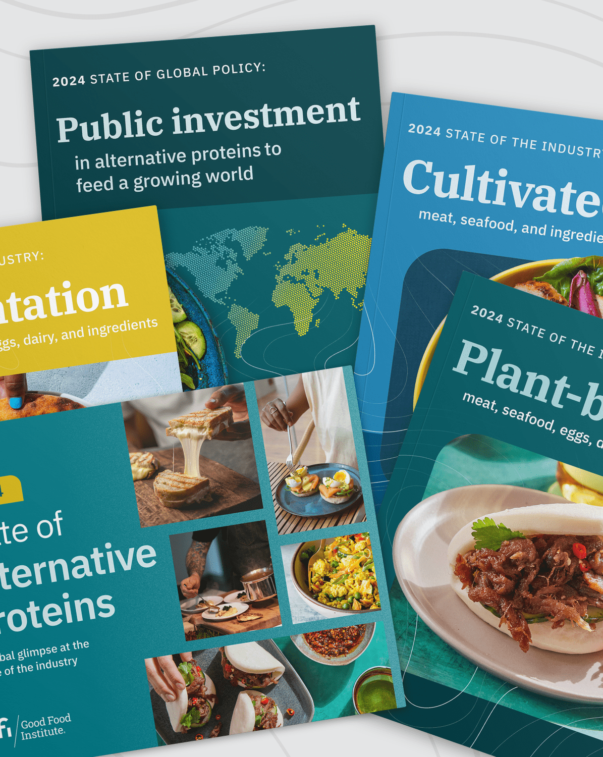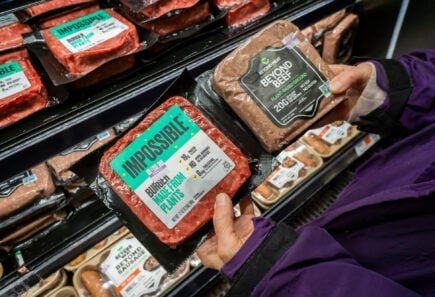
Manufacturing and producing alternative proteins
Identify product and category white spaces. Accelerate innovation. Scale the supply chain so that alternative proteins can be as accessible, affordable, and delicious as conventional animal products.
Insights in your inbox
Our monthly newsletter features the latest news and opportunities.
Product innovation guidance
Pioneering innovators in the alternative protein sector have jump-started a virtuous cycle of product and technology innovation, customer acquisition, investment, and scaled production. Recent years have seen several scientists, entrepreneurs, and corporations developing innovative ingredients, paradigm-shifting technological advances in production, and leading-edge marketing strategies.
Our guidance and resources help enable the food industry to deliver plant-based, cultivated, and other alternative protein products that compete on the key drivers of consumer choice: taste, price, and convenience.
Taste, price, and convenience
Innovate on taste
Taste is a primary motivator for consuming plant-based foods—and, simultaneously, the main barrier to consumer adoption.
- Seventy-three percent of consumers agree that plant-based meat should mimic the taste of meat.
- Forty-seven percent of consumers want more variety in plant-based meats.
- Fifty-one percent of consumers want more variety in protein sources for plant-based meat.

Close the price gap
Across categories, plant-based products are priced at a premium compared to animal-based products. Consumers say price is second only to taste in importance as an attribute when considering purchasing plant-based meat.
- Most consumers said they would pay less or the same for plant-based products compared to animal-based products.
- Only 27 percent said they would consider paying more.
Convenience appeals to all
Increasing access to plant-based food in mainstream grocery stores and restaurants is resulting in adoption from the largest group of consumers — omnivores.
- Seventy-six percent of consumers want to find plant-based meat in the meat aisle and frozen area where they already shop.
- Millennials rank convenience more highly than other groups do, and care about the ease of cooking & preparation.
To increase adoption of plant-based meat, manufacturers should consider:
- Creating delicious products that mimic the sensory qualities of animal products, including texture, smell, and taste.
- Scaling up production and pursuing technical innovation so alternative protein products reach price parity with conventional meat.
- Advocating for their products to be shelved in the meat aisle where most consumers seek out center-of-plate proteins.
For a deeper dive into the consumer insights that inform our recommendations, including product development, choice architecture, and consumer messaging, please check out our report on Strategies to Accelerate Consumer Adoption of Plant-Based Meat and visit our consumer insights.
Plant protein ingredients and processing
Our Plant Protein Primer is the go-to resource for understanding different plant-based protein sources. It includes an analysis of 19 plant protein sources with a summary comparing these sources on nutrition, functionality, price, flavor, and sourcing. For a quick glance, download the Plant Protein Landscape summary.
View our Plant-Based Meat Manufacturing by Extrusion Guide for an overview of plant-based meat processing and directories of ingredients, pilot facilities, co-manufacturers, and related events.
Scientific overview
Join the thousands of people who have signed up for GFI’s massive open online course on the science of plant-based and cultivated meat. The six-session self-paced course covers the biological and chemical processes used to produce plant-based and cultivated meat, the environmental and economic drivers behind these sectors, and the dietary roles of proteins.
Visit GFI’s in-depth pages on the science of plant-based protein, cultivated meat, and fermentation for a deep dive into these production platforms.

Resource
Insights and opportunities in whole-cut meat alternatives
Dive into a category overview and insights for plant-based and fermentation-enabled steaks, filets, chicken breasts, and other whole-cut products.

Resource
Plant-based and fermentation-enabled innovations for egg substitutes
Learn about innovations in egg substitutes and ingredients that offer reliable, cost-stable, and sustainable solutions for food companies.

Alternative protein value chains
Explore interactive maps from GFI APAC that break down the entire process of alternative protein production, including plant-based, cultivated, and fermentation-enabled methods. Learn about specific challenges and potential solutions within each stage of the value chain.
Technical resources

Selling into retail
We work directly with leading retailers to increase sales of plant-based foods by offering best practices on assortment, merchandising, and marketing.
View our retail resource page to learn which retail strategies can increase sales of plant-based meat, eggs, and dairy and grow total store sales.
Marketing plant-based foods
Our primary consumer research and literature reviews contain insights for labeling and marketing language that appeal to consumers and drive purchase intent:
- Marketing and Promoting Plant-Based Proteins offers insights for retailer promotion as well as labeling of individual products.
- GFI’s Retail Point-of-Purchase Motivators for Plant-Based Foods study provides effective category descriptors, product attributes, and packaging.
- Our Strategies for Accelerating Adoption of Plant-Based Meat paper highlights evidence-based best practices for product development and messaging.
Labeling guidance
A well-crafted product label can promote first-time purchases of plant-based products. Once consumers have tried plant-based products, they’re highly likely to buy them again.
Evidence-based product labeling recommendations:
- Use “plant-based” or “plant protein” as product descriptors.
- On-product health labels should focus on positive health benefits like “high protein” or “high fiber” instead of restrictive language like “low fat.”
- Develop positive messaging around the taste and sensory properties of plant-based meat. Use indulgent language that emphasizes product taste and the experience and enjoyment of eating.
- Highlight plant-based meat’s similarity to conventional meat in its ease and quickness of preparation.
- Message about altruistic benefits sparingly or only alongside appeals to traditional core drivers of food choice – taste, price, convenience, and familiarity.
- Emphasize plant-based meat’s increasing acceptability and prevalence.
- Design message content and framing with omnivores in mind.
For the rationale behind each of these tips, review the Strategies to Accelerate Consumer Adoption of Plant-Based Meat paper.

Selling into foodservice
Selling a product into foodservice offers several benefits for plant-based manufacturers:
- Guaranteeing your product is prepared in a standardized way before it reaches the consumer’s plate.
- Selling products at a premium.
- Reaching consumers who may not try it otherwise.
A growing body of evidence suggests that alternative proteins are a key growth driver for restaurants, helping them attract new customers and raise check sizes. View our foodservice resources for market data, menu ideas, and strategies for launching successful plant-based items in restaurant and non-commercial foodservice channels.
Quick tips for selling into foodservice
Here are three key tips for plant-based companies selling into foodservice:
Make foodservice sales sheets easily available on social media and your website.
Emphasize the versatility of your products and show the applications and dishes they can be used for. Share data on how you can attract new customers, raise check averages, and/or lower costs. Include per-serving costs to make it easy for operators to calculate profitability.
Tasting and testing are believing.
Do product training and tastings with your distributor sales teams and chefs. Also work with your operator prospects and partners on recipe development. Finally, partner with foodservice management companies and chef training groups like Forward Food to get your products in front of key decision makers.
Make taste the primary message.
Always emphasize flavor in your marketing and empower your foodservice partners to keep tastiness top-of-mind by providing image and descriptive assets they can repurpose.
Marketing and menu design
Key recommendations for effective plant-based product marketing and menu design include:
Lead with flavor.
Use indulgent language to emphasize that your product will offer familiar, craveable experiences consumers want.
Embrace the health benefits of plant-based.
Health is a key driver of interest in plant-based proteins; use health-positive language that highlights benefits, not what’s missing. These messages appeal to the nutritional halo of plant-based foods.
Position plant-based dishes to succeed with flexitarians.
List plant-based dishes alongside other items rather than in a separate vegan/vegetarian section where they won’t be seen.
Label dishes as “plant-based” or “plant protein.”
Favor more inclusive terms like “plant-based” or “plant-protein” over the terms “vegan” or “vegetarian” to appeal to more consumers and increase purchase intent.
Make plant-based options the default.
Make protein an optional add-on and include plant-based protein offerings.
Innovation opportunities for manufacturers
GFI has identified specific commercial white spaces that offer clear business opportunities for manufacturers in the industry. View our full solutions database for further ideas.
-
Cultivated
-
Fermentation
-
Plant-Based
Forging product development partnerships among ingredient suppliers and manufacturers
Opportunities exist to coordinate product development partnerships between ingredient suppliers, strategic partners, and product manufacturers to directly engage more holistically on product formulation.
-
Plant-Based
Fiber spinning innovations for improved plant protein texturization
Fibers from non-traditional texturization techniques like electrospinning, jet spinning, or blow spinning could impart texture throughout a product even if they don’t comprise the bulk of the end product, which…
-
Plant-Based
Expanded product development in plant-based meat snacks
Plant-based meat snacks could tap into underlying trends in snacks replacing meals and increased consumer interest in high-protein, low-sugar foods. Product innovation is needed to match the taste, price, and…
-
Plant-Based
Next-generation plant-based turkey products
There has been little in the way of publicly-announced R&D or commercial efforts to develop the next generation of tasty and affordable plant-based turkey products. There is room for innovation…
Engage with us
We help food industry partners to develop and market plant-based, cultivated, and other alternative protein products. We work with consumer packaged goods companies, large food and meat companies, and alternative protein companies. Our experts analyze the market, uncover consumer insights, identify whitespace opportunities, provide advice, make industry connections, and build communities. We do all this to enable the food industry to deliver alternative protein products that compete on the key drivers of consumer choice: taste, price, and convenience.
Specifically, we provide guidance to:
- Entrepreneurs and startups seeking to bring their ideas to market and fast-track growth.
- Manufacturers developing and bringing to market the next generation of alternative protein products.
- Ingredient companies creating the next generation of alternative protein ingredients and optimizing raw materials, inputs, and functional additives.
- Suppliers creating the next generation of ingredients and inputs, processing services, and other enabling technologies.
- Equipment manufacturers developing and commercializing equipment optimized for alternative protein production at scale.
We can also work under NDA to offer input at critical milestones in product development and provide marketing guidance to maximize sales.
Sign up for our industry newsletter
Finding these resources helpful? Get notified when we release new resources and opportunities by signing up for our newsletter!

"*" indicates required fields

Page
Environmental, Social, and Governance framework
GFI & FAIRR’s ESG frameworks supply investors and companies in the alternative proteins industry with tools to monitor, measure, and report on risks and opportunities.

Page
State of Alternative Protein series
Explore our comprehensive State of Alternative Proteins series for insights into the rapidly evolving alternative protein landscape.

Page
Consumer insights
Understand alternative protein consumer segments, demographics, adoption, motivations, and perceptions.













